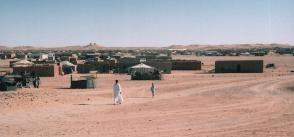
Growing barley in the desert
When considering the need to develop agriculture in the world, to grow food for animals or people, the Sahara Desert is certainly not the first location that comes to mind. But it’s precisely here that such an activity is perhaps the most necessary. According to the Food and Agriculture Organization of the United Nations (FAO), the prevalence of undernourishment in Africa rose from 20.8 percent in 2015 to 22.7 percent in 2016, affecting 224 million people on the continent. In the refugee camps of Western Sahara, which shelter more than 173,000 people who fled the disputed territory 35 years ago, the figures are more alarming: the malnutrition rate is as high as 40 percent, affecting mostly children, according to the Red Crescent.
The United Nations World Food Program (WFP) has sought to tackle this issue by setting up fodder production units in the Sahrawi refugee camps in Tindouf, southwestern Algeria. These units rely on hydroponic agriculture, which means the plants are grown on a material that’s naturally inert, such as sand. The technique requires no fertilizer and enables the production of fresh fodder for animals in desert regions or areas where the soil quality is too low for agriculture. Only water is needed.
It was a Sahrawi engineer, Taleb Brahim, who came up with the idea, and it was quickly adopted by the UN’s food aid agency, which provided the necessary funds to launch the initiative. Three hundred families living in the refugee camps are now beneficiaries of the project. Brahim himself is a resident of the camps. He presented his idea, named “Growing in the desert,” at the WFP Innovation Accelerator boot camp in Munich in 2017, where it was selected as the jury’s first choice.
Read the full article by Nadir Iddir | El Watan via Sustainable Development Goals blog.
[Photo by Joan Celda | Flickr]







